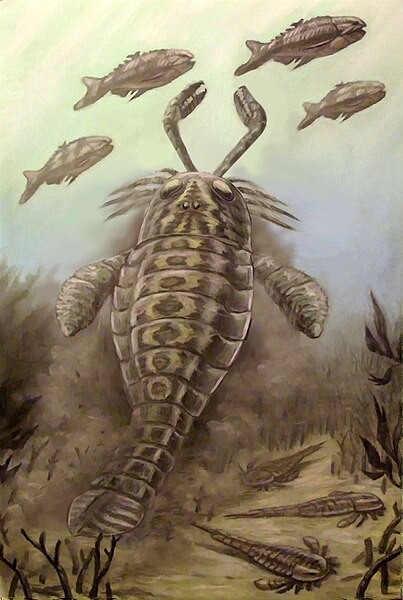Pterygotidae is a family of eurypterids, an extinct group of aquatic arthropods. They were members of the superfamily Pterygotioidea. Pterygotids were the largest known arthropods to have ever lived with some members of the family, such as Jaekelopterus and Acutiramus, exceeding 2 metres (6.6 ft) in length. Their fossilized remains have been recovered in deposits ranging in age from 428 to 372 million years old.
Pterygotidae
Fossil segment of Erettopterus osiliensis, showcasing the distinct scale-like ornamentation of the pterygotids.
Pterygotus and other eurypterids illustrated by Joseph Smit in 1896.
Restoration of Pterygotus hunting Birkenia.
Pterygotus is a genus of giant predatory eurypterid, a group of extinct aquatic arthropods. Fossils of Pterygotus have been discovered in deposits ranging in age from Middle Silurian to Late Devonian, and have been referred to several different species. Fossils have been recovered from four continents; Australia, Europe, North America and South America, which indicates that Pterygotus might have had a nearly cosmopolitan (worldwide) distribution. The type species, P. anglicus, was described by Swiss naturalist Louis Agassiz in 1839, who gave it the name Pterygotus, meaning "winged one". Agassiz mistakenly believed the remains were of a giant fish; he would only realize the mistake five years later in 1844.
Pterygotus
Painting painted in 1912 by Charles R. Knight depicting various eurypterids discovered in New York. The painting includes Dolichopterus, Eusarcana, Stylonurus, Eurypterus and Hughmilleria. Pterygotus can be seen in the center-left.
Illustration of fossils of P. anglicus, including three cheliceral claws.
Cheliceral claw of P. barrandei.








